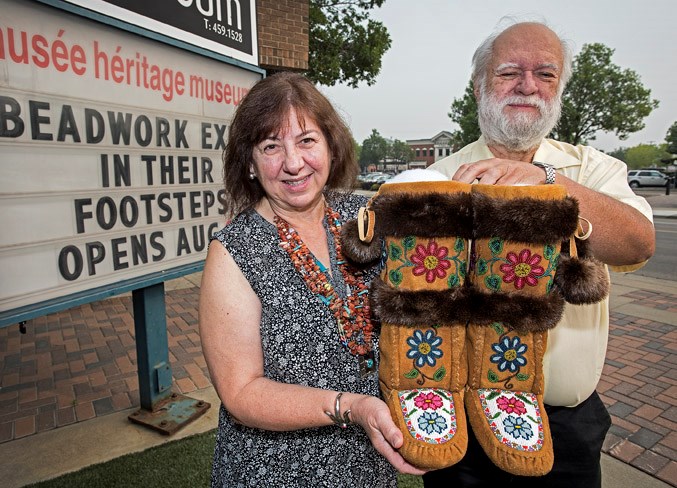Bill and Michelle Tracy have a heck of a lot of moccasins.
They have about 120 pairs of them in their Sherwood Park estate, and they’re still looking for more.
“It’s a disease,” joked Bill, who along with Michelle is a scholar of Indigenous art.
Seeing almost all of them crammed into the Musée Héritage Museum is staggering. Some are simple, plain items made from well-worn, yellowish leather. Many are lavishly decorated with fur trims and a rainbow of shiny beads arranged in flowers, geometric patterns, card suits and coats of arms. There are comfortable slippers, sporty high-tops, massive mukluks and itty-bitty baby shoes. There’s even a set with Mickey Mouse on them.
And Bill and Michelle haven’t worn any of them.
“We really do regard them as a traditional art form,” said Bill, who owns one set of mukluks for personal use. That means keeping them in pristine condition.
Albertans will get to share in the Tracy’s love of these soft-soled shoes through a new exhibit that opened Aug. 21 at the Musée. Called In Their Footsteps, it features some 107 pairs of moccasins and mukluks made since the 1900s by the Dené, Cree, Métis and Plains peoples of western Canada. It also has photos and profiles of many of the artists who made these pieces, most of whom were women.
“These women were very proud of what they made,” said Michelle, who met many of the artists personally.
“They made these beautiful things for the people they loved.”
Stepping through time
The Tracys have been studying and collecting Indigenous art for about 45 years as anthropologists, and have previously showcased parts of their vast collection at the Royal Alberta Museum, Art Gallery of Alberta and the Musée. Most of the pieces in this show are from their private collection.Moccasins have been made and worn by Canada’s Indigenous peoples for centuries. In addition to their practical purpose as footwear, Michelle said moccasins are an expression of culture and identity, and sometimes serve as a way to supplement a family’s income.
Making them starts with tanning hide, often from a moose or caribou – a laborious 10-day process Bill and Michelle experienced in the 1970s while living in Brochet, Man. It’s a tough, dirty job, as you have to scrape all the meat, hair and fat off the hide first.
You also had to contend with warble flies – parasites that leave hides infested with larvae that burst whenever you scrape them, Michelle said.
“You get covered in warble fly guts,” she said.
Once you’ve cleaned the hide, you treat it with lard and animal brains and wring it between poles to make it supple, Bill and Michelle said. You’ll often smoke it for colour at this point, keeping a careful eye out for scorch marks from sparks. Once the hide is ready, an artist will typically cut, sew and decorate a pair of moccasins over the course of a week.
The front of the exhibit features moccasins from the early 1900s. Unlike the ones people today are familiar with, these ones have pointy toes, a stitch line down the centre, a small instep and a small front piece that leaves little room for decoration, Bill said. The thinly coloured threads on these models are actually silk-wrapped horsehairs, while the square “beads” are dyed porcupine quills that have been folded flat – both features rarely seen in modern moccasins.
Bill said the more familiar round-top style – with its round front edge and wide top – took over western Canada in around the 1940s. While some sources say that this style came from the Inuit in the 1920s, others suggest it was the result of the Hudson’s Bay Company selling many Iroquois-made moccasins out west or the rise of rubber overshoes that didn’t fit the old pointy models.
“It may just have been a fashion change,” Bill said.
Mukluks emerged on the Prairies around the 1930s, having migrated here from Alaska, Bill said. Unlike the wraparound moccasins of the early 1900s, which featured leather uppers that went around your upper ankles, mukluks cover the whole lower leg and are often more weatherproof than Western snow boots.
A few moccasins in the show feature puffy flowers made from moose hair tufts. This technique was developed in part by artist Boniface Lafferty in response to a silk shortage during the First World War, and today is associated with the Fort Providence region southwest of Yellowknife, Bill said. To make the flowers, the artist sews bundles of dyed moose hairs to a moccasin and trims them with nail clippers, much as a gardener shapes a hedge.
Bill and Michelle say modern moccasins are becoming more art than footwear, with artists experimenting with lavish designs meant purely for show. One example in the exhibit is a set of store-bought shoes decorated with beadwork butterflies, the wings of which move when you walk.
Bill and Michelle say they hope visitors to the exhibit come away with a better understanding of Indigenous culture and this long-standing art form, one that is in no way dead.
“It’s still going on and people still use it,” Bill said.
“They’re creating new traditions,” Michelle added.
The exhibit runs until Oct. 21. Call 780-459-1528 for details.




